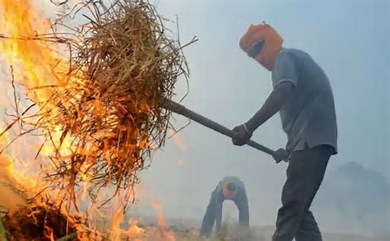In a concerning development for air quality in Northern India, Punjab has reported 379 fresh cases of stubble burning this season, with Sangrur leading the tally. The Punjab Pollution Control Board (PPCB) confirms that farm fires have spiked, especially in Sangrur, Ferozepur, and Tarn Taran, aggravating pollution in the region.
Sangrur Emerges as Top Contributor in Farm Fires
Among the 379 cases, Sangrur registered the highest number with 66 incidents. Ferozepur followed with 50, while Tarn Taran reported 42 cases. Other significant contributors included Bathinda (28), Moga (26), and Amritsar (27), according to PPCB data.
Smaller numbers were noted in districts like Fazilka (1), Rupnagar (2), and Hoshiarpur (2), showing a spread across the state as farmers push to clear fields.
Record-Breaking Spike in Farm Fires
This season saw its largest spike in farm fires on a single day, with 587 incidents reported on Friday alone. Sangrur, once again, led with 79 cases, followed by Ferozepur (70) and Tarn Taran (59). Since mid-September, Punjab has reported a total of 3,916 farm fire incidents, as per data from the Punjab Remote Sensing Centre.
Shrinking Window for Crop Sowing Pressures Farmers
The recent spike in stubble burning has been attributed to the shrinking window for wheat sowing. According to a senior agriculture official, farmers are feeling the pressure to clear paddy fields quickly to meet the November 15 deadline for wheat sowing, essential for a good yield.
“Farmers are resorting to stubble burning as it’s the fastest way to prepare fields for the next crop,” the official told Hindustan Times, underlining the urgency felt by farmers facing seasonal deadlines.
A Persistent Pollution Concern for Delhi
Stubble burning in Punjab and neighboring Haryana has long been blamed for exacerbating Delhi’s pollution levels in winter. Despite a 50% dip in farm fires from the previous years, experts warn that the rising incidents could once again impact Delhi’s air quality.
Farm Fire Statistics Over the Years
In 2023, Punjab recorded 36,663 farm fires, marking a 26% decrease compared to 2022’s 49,922 cases. However, incidents were far higher in previous years, with 71,304 cases in 2021 and a peak of 76,590 in 2020.
As the state braces for winter, the rising farm fires present a renewed challenge to efforts aimed at reducing air pollution.







